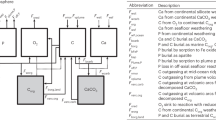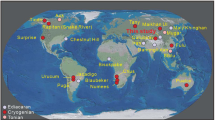Abstract
Present ionic concentrations of Ca ++,HCO -3 ,and HPO =4 in surface and groundwater runoff in Florida indicate that phosphorus is being concentrated in rock through dissolution and reprecipitation, with calcium phosphate increasing at the expense of calcium carbonate. Analog computer simulation of a systems model of this process suggests that significant enrichment can occur in 20 million years. The degree of enrichment depends on the supply of new phosphorus to Florida through rain and oceanic exchange processes. If the calcium phosphate content of original rock is 0.5 to 1.0 percent (0.52 to 1.05 percent P 2 O 5),a formation with 10 to 20 percent calcium phosphate (CaPO 4 or 10.5 to 21.0 percent P 2 O 5)as in the Hawthorn Formation (Miocene)may result. Nutrient upwelling along the continental slope coupled with transport to the estuaries by lateral eddy diffusion can supply an additional 400 mg P|m 2 |yr which, if deposited, would result in a sediment with a 4.3 percent CaPO 4 (4.5 percent P 2 O 5)content. If this is enriched later by resolution, 40 percent CaPO 4 (42 percent P 2 O 5)results. Through geologic time, the ocean may be considered as a source of phosphorus to the land through rain or estuarine sediment.
Similar content being viewed by others
References
Altschuler, Z. S., Clarke, R. S., Jr., and Young, E. J., 1958, Geochemistry of uranium in apatite and phosphorite: U.S. Geol. Survey Prof. Paper 314-D, p. 45–90.
Altschuler, Z. S., Cathcart, J. B., and Young, E. J., 1964, Geology and geochemistry of the Bone Valley Formation and its phosphate deposits: West Central Florida Guidebook, Fieldtrip No. 6, Geol. Soc. America, 68 p.
Barth, T. F. W., 1952, Theoretical petrology: John Wiley & Sons, Inc., New York, 416 p.
Bradley, J. T., 1972, Climate of Florida: National Oceanic and Atmospheric Administration, Washington, D.C., 10 p.
Brezonik, P. L., Morgan W. H., Shannon E. E., and Putnam H. D., 1969, Eutrophication factors in North Central Florida lakes: Florida Eng. and Ind. Exp. Sta., v. 23, no. 8, p. 1–101.
Brooks, N. H., 1960, Diffusion of sewage effluent in an ocean current,in Waste disposal in the marine environment: Pergamon Press, Elmsford, New York, p. 246–267.
Brown, L. P., 1904, The phosphate deposits of the southern states: Eng. Assoc. South Proc., v. 15, no. 2, p. 53–128.
Brown, P. M., 1958, The relation of phosphorites to groundwater in Beaufort County, North Carolina: Econ. Geology, v. 53, no. 1, p. 85–101.
Cathcart, J. B., and Davidson, D. F., 1952, Distribution and origin of phosphate in the landpebble district of Florida: U.S. Geol. Survey TEI Rept. 212, issued by U.S. Atomic Energy Comm., Tech. Inf. Service, Oak Ridge, Tennessee, 12 p.
Carr, W. J., and Alverson, D. C., 1959, Stratigraphy of middle Tertiary rocks in part of west-central Florida: U.S. Geol. Survey Bull. 1092, p. 1–109.
Chesselet, R., Morelli, J., and Menard, P. B., 1972, Some aspects of the geochemistry of marine aerosols,in The changing chemistry of the oceans: Wiley-Interscience, New York, p. 93–114.
Coker, R. E., 1935, The protection of birds made profitable: Science, v. 82, no. 2114, p. 10–12.
Cooke, C. W., 1945, Geology of Florida: Florida Geol. Survey Bull. 29, p. 1–314.
Cox, E. T., 1891, Floridite: a new variety of phosphate of lime: Am. Assoc. Adv. Sci. Proc., v. 39, p. 260–262.
Dall, W. H., and Harriss, G. D., 1892, Correlation papers: Neocene of North America: U.S. Geol. Survey Bull., v. 84, p. 134–140.
D'Anglejan, B. F., 1967, Origin of marine phosphorites off Baja California, Mexico: Marine Geology, v. 5, no. 1, p. 15–44.
Darton, N. H., 1891, Notes on the geology of the Florida phosphate deposits: Am. Jour. Sci., v. 3, no. 41, p. 102–105.
Davidson, W. B. M., 1892, Notes on the geological origin of phosphate of lime in the United States and Canada: Am. Inst. Min. Eng. Trans., v. 33, p. 139–152.
Freas, D. H., and Riggs, S. R., 1968, Environments of phosphorite deposition in the central Florida phosphate district: Proc. 4th Forum Geol. Industrial Mineral., Bur. Econ. Geol., Austin, Texas, 8 p.
Gibson, T. G., 1967, Stratigraphy and paleoenvironment of the phosphatic Miocene strata of North Carolina: Geol. Soc. America Bull., v. 78, no. 5, p. 631–650.
Green, J., and Holmes, J. A., 1947, Calculation of the pH of saturation of tricalcium phosphate: Jour. Am. Wat. Works. Assoc., v. 39, no. 11, p. 1090–1096.
Goldberg, E. D., 1963, The ocean as a chemical system,in The sea: Wiley-Interscience, New York, p. 3–25.
Gulbrandsen, R. A., 1969, Physical and chemical factors in the formation of marine apatite: Econ. Geology, v. 64, no. 4, p. 365–382.
Hutchinson, G. E., 1950, Survey of contemporary knowledge of biochemistry, part 3—the biogeochemistry of vertebrate excretion: Am. Mus. Nat'l Hist. Bull., v. 96, p. 1–554.
Kazakov, A. V., 1937, The phosphorite facies and the genesis of phosphorites,in Geological investigations of agricultural ores: Trans. Sci. Inst. Fertilizers and Insecto-Fungicides, v. 142, p. 95–113.
Kolodny, Y., and Kaplan, I. R., 1970, Uranium isotopes in sea-floor phosphorites: Geochem. Cosmochim. Acta, v. 34, no. 1, p. 3–42.
Ledoux, A. R., 1890, The newly discovered phosphate beds of Florida: Sci. Am. Supp., v. 30, no. 758, p. 12104–12105.
Murphy, R. C., 1927, The Peruvian guano islands 70 years ago: Nat. Hist., v. 27, no. 5, p. 439–447.
Odum, H. T., 1951, Dissolved phosphorus in Florida water: Florida Geol. Survey Rept. Invest. No. 9, p. 1–40.
Odum, H. T., 1957, Trophic structure and productivity of Silver Springs, Florida: Ecol. Mono., v. 27, no. 1, p. 1–111.
Odum, H. T., 1971, Environment, power, and society: Wiley-Interscience, New York, 317 p.
Odum, H. T., 1972a, An energy circuit language for ecological and social systems: its physical basis,in Systems analysis and simulation in ecology: Academic Press, New York, p. 140–210.
Odum, H. T., 1972b, Chemical cycles with energy circuit models,in The changing chemistry of the oceans: Wiley-Interscience, New York, p. 223–259.
Pevear, D. R., 1966, The estuarine formation of United States Coastal Plain phosphorite: Econ. Geology, v. 61, no. 2, p. 251–256.
Rusnak, G. A., 1967, Rates of sediment accumulation in modern estuaries,in Estuaries: Am. Assoc. Adv. Sci., Washington, D.C., p. 180–184.
Schneider, R. F., and Little, J. A., 1969, Characterization of bottom sediments and selected nitrogen and phosphorus sources in Lake Apopka, Florida: Fed. Wat. Poll. Cont. Adm., Southeastern Wat. Lab., 75 p.
Sellards, E. H., 1913, Origin of the hard rock phosphates of Florida: Florida Geol. Survey Ann. Rept., No. 5, p. 23–80.
U.S. Geol. Survey, 1961–1968, Water resources data for Florida, 1 and 2, 300 p.
Veeh, H. H., 1967, Deposition of uranium from the ocean: Earth Plan. Sci. Lett., v. 3, p. 145–150.
Vernon, R. O., 1951, Geology of Citrus and Levy Counties, Florida: Florida Geol. Survey Bull., v. 33, p. 1–126.
Vernon, R. O., and Puri, H. S., 1956, A summary of the geology of Panhandle Florida and a guidebook to surface exposures: Florida Geol. Survey for Geol. Soc. America Fieldtrip, 72 p.
Author information
Authors and Affiliations
Rights and permissions
About this article
Cite this article
Gilliland, M.W. A geochemical model for evaluating theories on the genesis of Florida's sedimentary phosphate deposits. Mathematical Geology 8, 219–242 (1976). https://doi.org/10.1007/BF01029271
Received:
Revised:
Issue Date:
DOI: https://doi.org/10.1007/BF01029271




